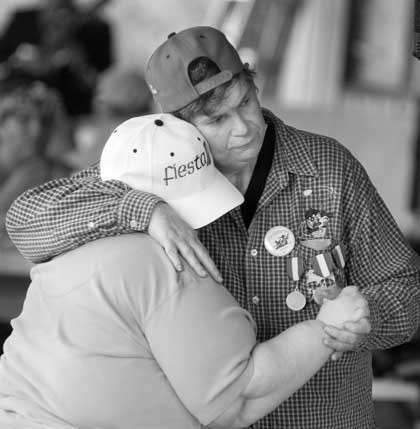Dressed in a gray T-shirt, baseball cap, and cotton pants, Matt looks like anyone you might see at church, the grocery store, or on a riverbank, relaxing with a fishing line in the water.
The previous day he had returned from a week-long trip home to Cleveland, Texas, where he celebrated his 44th birthday by going fishing with his family. “We caught two ice chests full of fish,” he tells me, spreading his hands about a foot apart, like many fisherman do when they’re telling stories of their big catch.
| Matt, shown here dancing at the San Antonio State School’s annual Fiesta celebration, has lived at the facility for more than 10 years. (Photo by Mark Greenberg) |
Matt lived at Abilene State School, a nursing facility, and several group homes before moving to San Antonio State School almost 11 years ago. He left the nursing home because of the expense, but enjoyed his life in group homes. In a workshop, he earned money packaging plastic silverware for airports and sorting nuts and bolts.
At SASS, his life is full. He spends time with his friends and works at the Developmental Center assembling sprinkler components. He uses the money to buy gifts for his fiancée and a new rod and reel and tackle box for himself.
Matt is articulate: He sings in the SASS church choir, and can read, write, and work. So I have to ask him, “Why are you here?”
“I have a disease, what do you call it?” he replies. “If you put food on this desk, the bookshelf, everywhere in this room, I would eat it all.”
Although Matt’s primary diagnosis is mental retardation, he also has Prader-Willi Syndrome, a genetic disorder that causes an uncontrollable desire to eat. In severe cases, people with Prader-Willi will eat inedible objects.
Matt writes the math problem “696 220” on a piece of paper and subtracts the numbers with a little help from his fingers. He smiles broadly. “I’ve lost 476 pounds.”
SASS doctors put Matt on a strict diet, but his health has suffered because of his prior obesity: Asthma, pneumonia, a hernia, heart surgery, a blocked airway. Twice, he nearly died.
Although Matt is his own legal guardian, his fragile health prompted his family to move him to SASS, a three-hour drive from Cleveland, as opposed to more than six when he lived in Abilene. “When I first came here, I was nervous and lonely,” Matt says. “I was very scared; I thought my family was going to leave me.”
He originally lived in another home at SASS, but transferred after run-ins with fellow residents. “There are two things I hate,” he says, “people teasing me and people bothering me.”
In his room hangs a sharp black suit that needs to be taken in because of his weight loss. He shows me a photo of Donna, his girlfriend of seven years, who lives at SASS, and was the school’s Fiesta Queen. He plans to marry her. “I like her laugh. She makes me happy, and when I’m sad, she’s always there. And she always asks about my mother.”
Matt’s mother is dying of cancer, and this is one reason why he has yet to move into the community: His family worries that the stress of her passing could temporarily affect his ability to cope in new situations. “I love her so much,” he says quietly, his voice cracking. “She’s in bad shape.”
Once Matt decides he wants to move into the community, SASS legally must prepare him for that transition by developing a discharge plan. “I want to get out of here and have a good-paying job, a wife,” he says. “And when I meet my goals, like getting to work on time, I will.” •
By Lisa Sorg
| Return to "Life at the bottom - Part 1" |


